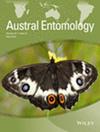Climatic and biotic influences on the distributions of Calliphora augur and Calliphora dubia (Diptera: Calliphoridae)
IF 1.1
3区 农林科学
Q3 ENTOMOLOGY
引用次数: 0
Abstract
Calliphora augur (Fabricius) and Calliphora dubia (Macquart) are two widespread and endemic Australian blowflies of applied importance. In order to better understand the biology of these species, this study used historical, field and laboratory data to determine and interpret their distributions. Locality records from insect collections and the literature were used to determine the known distributions of each species. The resultant maps were partially verified with field trapping data for each species. Calliphora augur was found to dominate in the east of Australia, while C. dubia dominates in the west. Comparative laboratory and field experiments were also used to derive parameters defining the distributions of these two closely related species, particularly in relation to temperature and moisture. Calliphora dubia had a greater tolerance for dry stress and high temperatures than C. augur, although maggots of both species displayed similar developmental temperature preferences. No difference was seen between species in the impact of low temperatures on the development of maggots through to the pupal stage. The greater ability of C. dubia to tolerate adverse environmental conditions is most likely linked to the shared evolutionary history of both species, in which increased aridity in central Australia is proposed to have triggered speciation by separating ancestral populations: C. dubia evolved in the hot, dry conditions in the west of Australia, while C. augur evolved in the cooler, moist environment of the east. Improved understanding of the influences on the distributions of these common Australian blowflies will assist in the further study of their application to agriculture and forensic science.气候和生物因素对大鲵和大鲵分布的影响(双翅目:大鲵科)
Calliphora augur (fabicius)和Calliphora dubia (Macquart)是两种分布广泛且具有重要应用价值的澳大利亚特有苍蝇。为了更好地了解这些物种的生物学,本研究利用历史、野外和实验室数据来确定和解释它们的分布。利用昆虫收集的地方记录和文献来确定每个物种的已知分布。所得到的地图与每个物种的野外捕获数据进行了部分验证。澳大利亚东部以Calliphora augur为主,西部以C. dubia为主。对比实验室和实地实验也被用来确定这两个密切相关的物种的分布参数,特别是与温度和湿度的关系。尽管这两个物种的蛆表现出相似的发育温度偏好,但dubia Calliphora对干燥胁迫和高温的耐受性比c augur更强。在低温对蛆发育到蛹阶段的影响方面,不同物种之间没有差异。C. dubia耐受恶劣环境条件的能力更强,很可能与这两个物种共同的进化史有关,其中澳大利亚中部日益严重的干旱被认为是通过分离祖先种群引发物种形成的原因:C. dubia在澳大利亚西部炎热干燥的环境中进化,而C. augur在东部凉爽潮湿的环境中进化。进一步了解对这些常见的澳大利亚苍蝇分布的影响将有助于进一步研究它们在农业和法医学上的应用。
本文章由计算机程序翻译,如有差异,请以英文原文为准。
求助全文
约1分钟内获得全文
求助全文
来源期刊

Austral Entomology
ENTOMOLOGY-
CiteScore
3.20
自引率
0.00%
发文量
40
期刊介绍:
Austral Entomology is a scientific journal of entomology for the Southern Hemisphere. It publishes Original Articles that are peer-reviewed research papers from the study of the behaviour, biology, biosystematics, conservation biology, ecology, evolution, forensic and medical entomology, molecular biology, public health, urban entomology, physiology and the use and control of insects, arachnids and myriapods. The journal also publishes Reviews on research and theory or commentaries on current areas of research, innovation or rapid development likely to be of broad interest – these may be submitted or invited. Book Reviews will also be considered provided the works are of global significance. Manuscripts from authors in the Northern Hemisphere are encouraged provided that the research has relevance to or broad readership within the Southern Hemisphere. All submissions are peer-reviewed by at least two referees expert in the field of the submitted paper. Special issues are encouraged; please contact the Chief Editor for further information.
 求助内容:
求助内容: 应助结果提醒方式:
应助结果提醒方式:


